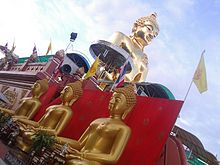The Golden Triangle (สามเหลี่ยมทองคำ Saam Liam Thong Kham) is in Chiang Rai Province, in the far north of Thailand. The name was coined in the 1960s to refer to the opium-cultivating regions of Laos, Myanmar and Thailand but nowadays the northern Thai tourism industry uses it to refer to the tripoint where the three countries meet. Locals call this spot Sop Ruak, since this is where the Mekong meets the Ruak River.
Understand
[edit]
Historically the Golden Triangle has been an area well-known for the growing of opium, and the name comes from a US State Department memo on the practice. These days, though, the place lives on the cultivation of tourists, and this is undoubtedly the largest tourist trap in northern Thailand.
The landscape is hilly, divided by the Ruak River that flows into the Mekong (Mae Khong) River. These rivers form a natural boundary between the three countries Laos (to the east of the Mekong), Myanmar (to the north of the Ruak), and Thailand (to the west of the Mae Khong).
Get in
[edit]Most people seem to come here on guided bus tours. For independent travellers, blue songthaews run through the Golden Triangle from Mae Sai (45 min, 40 baht) to Chiang Saen (15 min, 20 baht) and back again every 20 minutes or so until around 15:00. If you miss the last songthaew, you will be at the mercy of the tuk-tuk and motorcycle taxi drivers who will charge around 70 baht for the 10 km trip from the Golden Triangle to Chiang Saen.
Get around
[edit]Boats can be hired to view scenery around the golden triangle from Sop Ruak along the Mekong River to Chiang Saen and Chiang Khong which takes around 40 minutes and one and a half hours respectively.
See
[edit]

The main area is the Thai riverside near the point where the rivers meet, which, in the dry season, when the Mekong runs low, is even marked by a handy sandbar. This in itself is pretty anticlimactic, so a series of increasingly bizarre attractions have been erected by the riverside to make up for it: there's a giant golden Buddha on a ship, elephant statues where you can clamber to pose atop a palanquin (in exchange for a donation, of course), elaborate shrines to the royal family, half a dozen signs stating that yes, this really is the Golden Triangle and, inevitably, river cruise touts, souvenir shops and Western-style cafes.

- 1 Hall of Opium, Golden Triangle Park (หอฝิ่นอุทยานสามเหลี่ยมทองคำ), Moo 1, Ban Sop Ruak, Wiang (around 2 km north of center, on the way to Mae Sai), ☏ +66 53 784444-6. Tu-Su, 08:30-16:30. One of the best museums in all Thailand and almost certainly the most interesting place to visit in the Golden Triangle, the Hall of Opium exhibits the history of opium around the world and in the area, the process of production, the effects of opium smoking and campaigns to eradicate and substitute the crop. There's even a tiny opium plantation inside! The hall describes itself as "edutainment", and indeed this is something of an opium theme park, with the latest in snazzy multimedia exhibits and lots of subtle hectoring about the evils of addiction. To their credit they don't whitewash Thailand's own history at all and even the CIA's exploits are covered in detail. Popular with tour groups and school children. Run by the royal Doi Tung Foundation, with profits going to charity. 200/150 baht foreigners/Thai.
- 2 House of Opium, 212 Moo 1, Ban Sop Ruak, Wiang. 07:00-19:00. A privately-run museum, associated with a souvenir shop, it is unrelated to and much smaller than the hall and lacks their sophisticated presentation. Lots of opium paraphernalia and information on the production process from beginning to end. 50 baht.
- Phra That Doi Pu Khao (พระธาตุดอยปูเข้า) (On the hill just before the Golden Triangle). Believed to have been built by a king of Wiang Hirannakhon Ngoen Yang in mid-8th century. Remains of antiquities are in the Viharn with crumbled chedis.
Do
[edit]- Take a photo at the gate marking the Golden Triangle.
- Go on a boat ride across to a small island named Don Sao, belonging to Laos. No visa for Laos is required to make this trip. This is popular among tourists, and many small boats offer this service. The island is in Laos, and should you be so inclined you could claim to have visited the country, although you are not allowed to enter into the rest of Laos from there without a visa.
Eat
[edit]There are a number of scruffy bamboo-built cafes as you come in from the north, and then a chain of largely identical-looking cafes and restaurants along the riverside promenade.
- Sriwan (Opposite Imperial Hotel). Clean, friendly and tasty restaurant on the riverbank, offering a wide menu of all the usual Thai and Western dishes. Noodle and rice dishes start from 40 baht. 100 baht.
Drink
[edit]Sleep
[edit]A sprawl of guesthouses and hotels has popped up on the Thai side of the river. However, better accommodations can be found in Chiang Saen, Chiang Khong and Chiang Rai, and most visitors choose to visit as a day-trip.
Stay safe
[edit]Go next
[edit]- Exit through the Thai-Myanmar border in Mae Sai
- South to the historical city of Chiang Saen.
- Southeast to Laos via Chiang Khong.
- By bus, rental car or taxi to Chiang Rai.



